 |
Fuerte de San Felipe de Bacalar
Bacalar, Quintana Roo, Mexico
|
|
 |
Constructed: 1725-1733
Used by: Spain, Mexico
Conflict in which it participated:
The Caste War of Yucatán
|
The reason a starfort was built at this exceedingly far-flung outpost of the Spanish empire will, I absolutely guarantee, make your eyes glaze over: Haematoxylum campechianum.
The 18th-century clothiers amongst us will of course recognize these scary words as dyewood, a flowering tree native to southern Mexico, from whence a red or purple dye can be extracted. In the days before chemical dyes were created, trading in the flora that provided dye to Europe was a lucrative business indeed. And who was interested in obtaining dyewood? Pretty much anybody with a ship. |
 |
|
|
In the 16th through 18th centuries, that included France, Holland, England and various piratical amalgamations emanating from those places...but as was the case with most places in Central America, the Spanish got there first. The little Mayan town of Bakhalal ("near or surrounded by reeds") was introduced to the glorious Spanish empire in 1531, thanks to Francisco de Montejo (1479-1553).
Montejo's minions had been busily conquering much of the Yucatán peninsula through the late 1520's, and attempted to etablish a settlement and garrison at Bakhalal, but the locals weren't having it, and repeated Mayan surprise attacks drove the Spanish back into the sea. A second determined effort to occupy the region came in 1543: A "good number" of indiginous persons were "subdued," and what one imagines was an equally good number of Spaniards were installed at the newly-renamed Salmanca de Bacalar...but the Spanish stronghold in the Yucatán, Mérida, was all the way on the other side of the peninsula, with great hordes of furious Mayans prowling the hinterlands. Even communicating with the authorities was difficult, much less any reasonable expectation of timely relief should a delicate situation crop up, so the Spanish hold on Bacalar remained a shaky one.
|
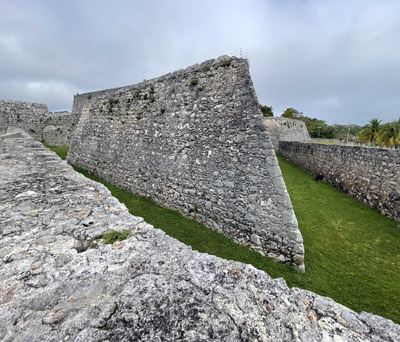 El fuerte's business end: The beautiful ravelin! El fuerte's business end: The beautiful ravelin! |
 |
While the Spanish outpost at Bacalar was an important landing point for folks headed to and coming from their other Central American colonies of Guatemala and Honduras, it had a remarkably small footprint: Around 30 settlers were holding down this port for Spain in the 1630's. Unsurprisingly, pirate activity was rampant. Anywhere the Spanish were removing valuable things from their colonies, there would be pirates lurking in the shadows, and the canals and marshy areas around Bacalar made for ease of sneaky transport.
In 1638 Scottish pirate Peter Wallace founded a settlement 50 miles south of Bacalar, in the interest of having a protected place from whence to launch raids on the Spaniards. Eventually it dawned on the pirates that they could cut their own dyewood there... |
|
...or, even better, they could ship African slaves over to do the log-cutting for them! Somehow this pirate cove went legit, and in 1716 it became the English colony of British Honduras (presently it's called Belize), which the Spanish allowed to officially exist, so long as the English stationed there assisted in controlling the pirate problem...which pirate problem, one might point out, the English had established in that very place.
But the English were far from the only seaborne threat faced by the Spanish in Yucatán. In 1652, Bacalar was completely destroyed by the forces of a most wicked and dreadful pirate known as Diego el Mulato. In true pirate fashion, this was a name used by several pirates over a century or so...the Diego who did the dastardly deed of destroying Balacar was (probably) actually named Diego de los Reyes. And dastardly indeedy-dee he was, with reports of him having "undressed (altar) images, chopped them to pieces with axes, and dressed up in mockery"...and you can't get much worse than that, in the eyes of the Catholic church.
|
At long last, the Spanish got fed up with being killed by land by Mayans and by sea by pirates, and the ultimate defensive entity of the era was wielded: The starfort option. Antonio de Figueroa y Silva (d. 1733) ascended to the throne of Captaincy General of Yucatán in 1725, and immediately started working towards reestablishing Spanish authority over Bacalar.
Showing just how serious and well-informed he was regarding the proper design of starforts, Silva contracted an Italian engineer by the name of Juan Podio to build the fort.
|
 |
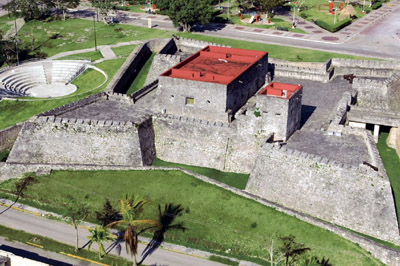 Though she be but little, she is fierce. Though she be but little, she is fierce. |
|
Podio built a lovely little four-bastioned starfort, with a charming connected ravelin, out of the materials available at that time and place: Anyone who has squinted at the walls of the majestic Castillo de San Marcos in Florida will recognize coquina, and volcanic rocks and limestone were also jammed in there. Supposedly Podio went with four bastions so as to properly honor the saints of Santa Ana, San Arturo, Santa Maria, and San Joaquin... sure he did. Likely that's what he told his violently Catholic employers, whilst rolling his eyes. |
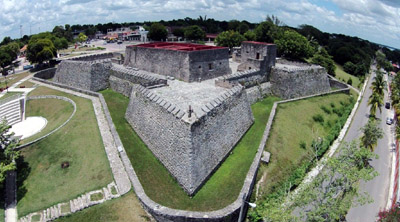 I don't know what dronemaster is responsible for this absolutely superlative shot, but I wish to thank them from the bottom of my heart. I don't know what dronemaster is responsible for this absolutely superlative shot, but I wish to thank them from the bottom of my heart. |
 |
Thanks to its new and impregnable fortress, proudly named el Fuerte de San Felipe de Bacalar (when attempting to determine which San Felipe this fort was named for, you may choose from something like ten assorted Saints Felipe), the Spanish colony at Bacalar was now secure from anything those silly pirates might throw at it. Dyewood, mahogany, fruits, sugar, goats and pigs were exported with wild abandon, and everything was absolutely fantastic. Another starfort seals the successful future of a Spanish colony! The end!
Almost. Sadly for the Hispanic Mexicans, there were still disaffected Mayans lurking in the weeds. |
|
Mexico declared its independence from Spain in 1810, and finally threw off the imperial yoke in 1821. Independence more or less worked out for the Mexican ancestors of Spain, but things didn't improve much for the indiginous persons still attempting to exist in Yucatán. 1847: Bacalar was a bustling metropolis of 5,000 hard-working, enterprising Hispanic souls. The Mayans had been pushed around, marginalized, murdered and generally oppressed by the Spanish (and now the Mexicans) for some 300 years, and were finally ready to do something about it! The Caste War (1847-1901) threw Yucatán into bloody chaos, and on February 21, 1858, the maraudin' Mayans made it to Bacalar.
The city was devastated, its shiny starfort unable to hold back the tide of shrieking Mayans. Was the fuerte of our current interest even defended against this Mayan juggernaut? If so, mention of it has escaped historic note.
Those Hispanic Mexicans who managed to survive the onslaught on Bacalar escaped and (wisely) cowered in British Honduras. El Fuerte de San Felipe de Bacalar was occupied by the Myans, but it doesn't appear that they stuck around for long to gloat over their fortificational acquisition...the city was left mostly depopulated for the next 55 years, while this lengthy and messy conflict made Yucatán a particularly unpleasant place.
|
Due to increasing British investment in Mexico, the dreaded lobsterbacks got involved in this war on the side of the Mexican government in what was ultimately a not-very-effective manner. Most of the major fighting seems to have been over by the 1880's, but accomplishing much of anything of a sweeping military nature (beyond sweating) in the thickly-forested Yucatán proved impossible for the Mexicans for a couple more decades.
At long last, Bacalar was returned to the Mexican fold in 1902, with the arrival of a force commanded by Vice Admiral Ángel Ortiz Monasterio Irizarri (1849-1922). The Mayans kept fighting until 1915, when they were finally convinced of how great it is to be a Mexican.
|
 |
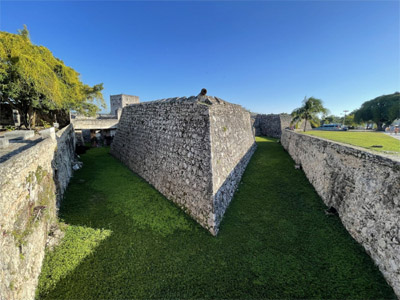 Tired of looking at el fuerte's bastions (of which this is one) and ravelin (which is enpicted further up on this page)? Tough toenails! You arrived at this page under your own free will, cowboy! Tired of looking at el fuerte's bastions (of which this is one) and ravelin (which is enpicted further up on this page)? Tough toenails! You arrived at this page under your own free will, cowboy! |
|
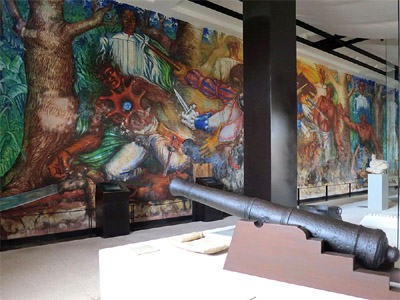 Inside the museum at el Fuerte de San Felipe de Bacalar today: Elio Carmichael's mural. Inside the museum at el Fuerte de San Felipe de Bacalar today: Elio Carmichael's mural. |
 |
As well-built starforts usually are, el Fuerte de San Felipe de Bacalar was utilized for various semi-important military things by the Mexican government through much of the 20th century, until it was declared a "National Historical Heritage" in 1965, and a museum was established in one of its bastions.
This lasted until 1974, whereupoin it was closed to the public, only to be reopened in 1983, sporting a snazzy new mural by local artist Elio Carmichael (1935-2014), which depicts important regional events, such as Mayans being stabbed with swords and pikes in the jungle. The expected collections of weapons, utensils and maps are reportedly on display.
|
|
Admission to el fuerte's museum costs $20 as of this writing in 2022, unless you are unfortunate enough to be a "foreigner," in which case you will be expected to pony up a whopping $50.
|
|
|
|
|
|
 |




